 Back in June, I published a post about a set of bills moving through the Massachusetts State Legislature that would have allowed temporary door locking devices, AKA barricade devices. You can read the original post here.
Back in June, I published a post about a set of bills moving through the Massachusetts State Legislature that would have allowed temporary door locking devices, AKA barricade devices. You can read the original post here.
The last day of the legislative session in Massachusetts was last week – July 31st, 2024. As far as I can tell from the available information, the bills were not finalized during the session and will not continue to progress through the legislative process – they would need to be refiled in the next session. If someone knows otherwise, please get in touch with me.
Although this is a pause in the efforts to use legislation to modify the adopted codes rather than making changes via the code development process, bills like these can lead to confusing information being shared in the media. For example, regarding temporary door locking devices, an article in This Week in Worcester states: “These devices, which attach to doors at the floor or ceiling level, offer enhanced protection compared to standard door latches that can be easily compromised.”
Locks used in schools and other institutional buildings are not “easily compromised”, and the Final Report of the Sandy Hook Advisory Commission states: “The testimony and other evidence presented to the Commission reveals that there has never been an event in which an active shooter breached a locked classroom door.” There is no evidence to show that temporary door locking devices offer “enhanced protection”, as stated in the article.
The article also states: “Temporary door locking devices were credited with saving lives during the 2021 Oxford High School shooting in Michigan.” Based on an independent report on the Oxford shooting, the editor of Campus Safety Magazine issued an update about the use of classroom barricade devices, which can be found here. I highly recommend reading the update, if not the full independent report, to learn more about the impact of locked doors at Oxford High School.
In January, I attended an online joint meeting of the Massachusetts AIA chapter and the BSA – Boston Society of Architects. The purpose of the session was to discuss temporary locking devices and the Massachusetts bills. The video of this meeting is available on the Government Affairs Committee page of the AIA-MA website and it is well worth watching! (Click the link for the January 25th minutes.) Michael Dorn of Safe Havens International spoke at length about the concerns associated with barricade devices, and his insight was very compelling.
It is crucial to continue educating facility managers, school administrators, code officials, legislators, and others about the concerns associated with barricade devices. This article from Door Security + Safety can be shared with anyone who wants to learn more.
~~~
Barricade devices such as the examples shown below are not currently allowed by the building codes, fire codes, and accessibility standards adopted in Massachusetts.
You need to login or register to bookmark/favorite this content.


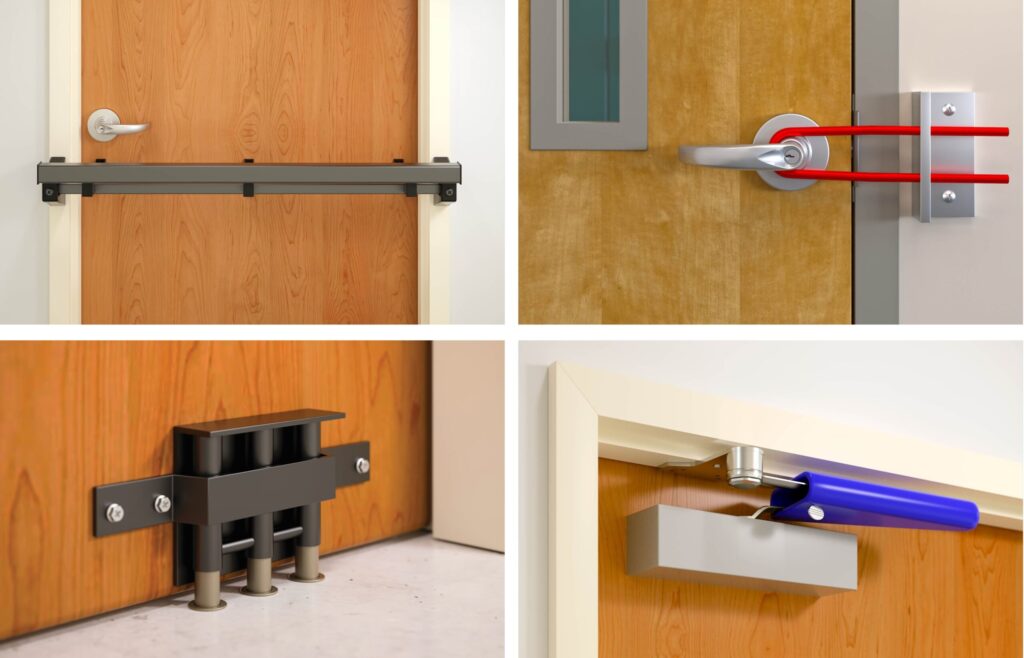
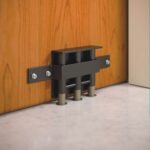
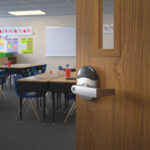
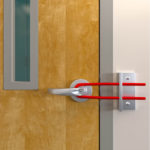
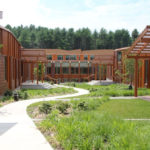




Thanks for an update. I had wondered if it passed in the late hours of the session.
I don’t think so, but if you hear otherwise, please let me know.
– Lori
Lori, you have been a crusader on the class room door barricades issue. Keep up your fight and keep educating the people concerned, the authorities, AHJs and the Code officials.
Thanks Hamza! I hope eventually I can stop crusading! 🙂
– Lori
Wondering if in the future building designs will better address the issue by providing small alcoves so that all doors can swing out. This would provide a much more difficult barrier to anyone trying to “force” their way into a classroom. Even the most simply locked outward swing doors are hard to force without tools. Additionally the alcove would serve as cover/concealment from a shooter in the hallway. Of course the downside is this would also give a shooter cover when engaged by LEO’s. Main point being a shooter will likely be unable to penetrate an outward swinging fire door with just the simplest latch without carrying a forcible entry tool, whereas inward swinging doors need more robust locking/latching to prevent being kicked in.
Hi Adam –
I have seen some new schools designed with alcoves and areas to “hide” in the corridor, but this creates other problems. I agree that outswinging doors are more difficult to defeat, but in past school shootings the shooters have not typically spent a lot of time trying to access locked rooms. Locked doors that allow free egress will go along way toward protecting students and teachers, even if the doors are inswinging.
– Lori
Agreed on all counts, just hoping that we’re moving forward on all fronts that result in enhanced safety for new threats without reducing the safety that has been built in for “legacy” threats.
That’s my hope too! 🙂
– Lori